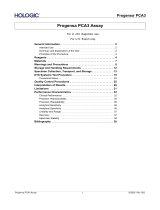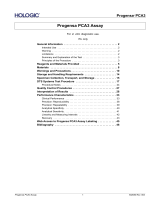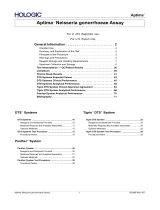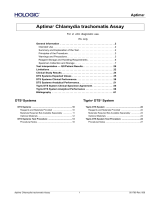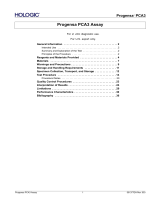Page is loading ...

For Research Use Only. Not for use in diagnostic procedures.
OncoScan™ CNV Assay v1.1 Assay
Software Module
User Guide
Document Part Number 703348
Publication Number MAN0018308
Revision A.0

Affymetrix Inc. | 3450 Central Expressway | Santa Clara, CA 95051 | USA
The information in this guide is subject to change without notice.
DISCLAIMER: TO THE EXTENT ALLOWED BY LAW, THERMO FISHER SCIENTIFIC INC. AND/OR ITS AFFILIATE(S) WILL NOT BE LIABLE
FOR SPECIAL, INCIDENTAL, INDIRECT, PUNITIVE, MULTIPLE, OR CONSEQUENTIAL DAMAGES IN CONNECTION WITH OR ARISING
FROM THIS DOCUMENT, INCLUDING YOUR USE OF IT.
Revision history: Pub. No. MAN0018308
Revision
Date
Description
A.0
07 December 2018
• Initial release in Thermo Fisher Scientific document control system.
• Supersedes legacy Affymetrix publication number 703348.
• Updated to the current document template, with associated updates to trademarks,
logos, licensing, and warranty.
Important Licensing Information: These products may be covered by one or more Limited Use Label Licenses. By use of these
products, you accept the terms and conditions of all applicable Limited Use Label Licenses.
TRADEMARKS: All trademarks are the property of Thermo Fisher Scientific and its subsidiaries unless otherwise specified.
©2018 Thermo Fisher Scientific Inc. All rights reserved

OncoScan™ CNV Assay v1.1 Assay Software Module User Guide
3
Contents
Introduction ............................................................................................................................ 4
Nomenclature ......................................................................................................................... 4
Features of OncoScan CNV ASM ............................................................................................ 4
Reagents.................................................................................................................................. 4
Installing the ASM .................................................................................................................. 5
Installing the Certificate ................................................................................................................................. 5
Installing the ASM ........................................................................................................................................... 6
Firewall Issues ............................................................................................................................................ 9
Repairing Currently Installed ASM ...................................................................................................... 10
Creating a Test Request .......................................................................................................... 11
Adding Specimen Information ............................................................................................... 12
The Assay Information/Home Window................................................................................. 13
Adding Reagent Information ....................................................................................................................... 13
Reagent Kit Information ............................................................................................................................... 14
Reagent Entry Information........................................................................................................................... 15
Reagent Kit Lot Numbers and Expiration Dates ....................................................................................... 15
Expiration Date Scenarios ....................................................................................................................... 15
Specimen Report Tab .................................................................................................................................... 16
Test Request Log Tab .................................................................................................................................... 17
Batching Additional Test Request Information ....................................................................... 18
Gridding Manually ................................................................................................................ 19
Transferring Data .......................................................................................................................................... 19
Reviewing the Test Report ........................................................................................................................... 20
Ordering Information ............................................................................................................. 22

4
OncoScan™ CNV Assay v1.1 Assay Software Module User Guide
OncoScan™ CNV Assay v1.1 Assay Software Module
Introduction
This User Guide demonstrates how to create an OncoScan CNV Assay v1.1 ASM RUO Assay Test
Request. This software is for use with the GCS3000Dx v.2 system and is also compatible with the OncoScan
CNV Plus Assay.
Nomenclature
•The Assay name is OncoScan™ CNV Assay.
•The Assay display name is OncoScan™ CNV v1.1
•The term ASM refers to Assay Software Module.
Features of OncoScan CNV ASM
OncoScan CNV features 4 windows that augment your assay record keeping.
•Additional Information window
•Assay Home window (or Assay Landing window)
•Batch Edit window
•Report window
OncoScan CNV ASM (under the control of the AMDS application), transfers all specimen information to
the server.
IMPORTANT: It is
NOT
the purpose of this abbreviated User's Guide to instruct you on how to
run the Assay. This guide instructs only how to create a RUO Test Request and track associated
information.
To complete an Assay run, you must follow the standard AMDS Assay protocols, then process it through
the workflow to register, hybridize, wash/stain, and scan the array (as part of the array cartridge). These
specifics are discussed in the Affymetrix Molecular Diagnostic Software User Guide (Pub. No. 08-0261).
IMPORTANT: Before using the information contained in this guide to run the assay, you
must thoroughly be familiar with the following documents:
•Affymetrix Molecular Diagnostic Software User Guide (Pub. No. 08-0261)
•Affymetrix Molecular Diagnostic Software Quick Reference (Pub. No. 08-0262)
•OncoScan™ CNV Plus Assay Kit User Guide (Pub. No. 703175)
Reagents
Reagents for the OncoScan™ CNV Assay - single array (P/N 521191) comprise the following Reagent Sub-
Kits and their associated part numbers:
•OncoScan™ CNV Buffer C (P/N 902687)
•OncoScan™ Copy Number Probe Mix 1.0 & Controls (P/N 902688)
•OncoScan™ CNV Gap Fill and 1st Stage PCR (P/N 902689)
•OncoScan™ CNV 2nd Stage PCR and Post PCR (P/N 902690)

OncoScan™ CNV Assay v1.1 Assay Software Module User Guide
5
•OncoScan™ CNV Stain Reagents (P/N 902691)
•Wash Buffer A (P/N 901680)
•Wash Buffer B (P/N 901681)
Installing the ASM
To process an OncoScan CNV Test Request on the system, you must first:
1. Install a Certificate (only for secure transfers to a Data Transfer Server and not required for CIFS
transfers).
2. Install the ASM.
Installing the Certificate
NOTE: In most cases, the Field Service Technician installs the certificate and ASM.
NOTE: The steps in this section apply only if you are using a Data Transfer Server. If you
are transferring your data via CIFS, SKIP to
Installing the ASM
on page 6.
As a security measure, AMDS requires that you or the field service technician install a SSL server certificate
on your local workstation in order for your workstation to communicate with the server. This is required
for the transfer of OncoScan CNV Assay test request data to the Data Transfer Server.
The service technician should have installed a certificate at the time of the system's installation. If for some
reason the service technician did not install a certificate or if the server has changed after the system's initial
installation, you must install or reinstall a certificate.
You MUST install the certificate before installing the Assay.
If a proper certificate has not been installed, you can still install the assay and process test requests;
however, you will not have permission to access the server, and you cannot transfer test request data to the
server.
If you cannot access the server and have already installed a certificate, contact Technical Support.
NOTE: You must be logged in with either Laboratory Supervisor or System Maintainer
privileges to install a certificate.
The Active Worklist Administrator panel contains the Assay Management button and provides the starting
point for installing a certificate (Figure 1.1).
Figure 1.1 The Active Worklist Administrator Pane (lower left)

6
OncoScan™ CNV Assay v1.1 Assay Software Module User Guide
1. Insert the CD into the drive.
2. Click Assay Management.
The Assay Management window appears.
3. Click Install Certificate.
The Please select a server certificate to install window appears. (Figure 1.2)
Figure 1.2 The Server Certificate Browse window.
4. Make sure the Install from CD radio button is selected, then navigate to and click the
appropriate .cerfile.
5. Click OK.
The message You have successfully added the server certificate xxxxx.cer to the AMDS trusted
certificate store appears.
NOTE: If the certificate installation fails, an error message appears. You cannot access
the server or transfer data without a certificate. Contact your Service Representative for
information on obtaining a new certificate.
6. Click OK to return to the Assay Management window.
Installing the ASM
The ASM installation process is relatively simple. It requires the selection of a manifest file and the selection
of approved user access.
NOTE: You must be logged in with either Laboratory Supervisor or with System
Maintainer privileges to install an Assay Software Module.
1. Insert the CD into the drive.
2. Click Assay Management.
The Assay Management window appears.
3. Click Install Assay.
The Assay Installation window appears. (Figure 1.3)

OncoScan™ CNV Assay v1.1 Assay Software Module User Guide
7
Figure 1.3 The Assay Installation window
4. Click Browse.
The Locate Manifest File window appears. (Figure 1.4)
Figure 1.4 The Assay Installation Browse window
5. Make sure the Install from CD radio button is selected, then navigate to and click
on D:\\OncoScan_CNV_v1.1\oncoScan_cnv_v1.1.manifest

8
OncoScan™ CNV Assay v1.1 Assay Software Module User Guide
5. Click OK.
The Assay Installation window appears. (Figure 1.5)
Figure 1.5 The Assay Installation browse window for the OncoScan CNV
6. Click to choose each authorized Assay User or click Select All.
7. Click Install.
The Remote Device Settings window appears. (Figure 1.6)
Figure 1.6 The Remote Device Settings window
NOTE: In AMDS 1.1.1, users can enter their transfer location either as a WebDav URL
(e.g. https://dx2_webdav_server/dx2_ruo) or as a Common Interface File System
(CIFS) folder designation (e.g. \\dx2_cifs_folder\dx2_ruo_files). For AMDS releases
prior to AMDS 1.1.1, only the WebDav option is available.
8. Locate and enter the NA Device URL. This is the location where AMDS sends its completed Assay
data.

OncoScan™ CNV Assay v1.1 Assay Software Module User Guide
9
9. Enter the NA Device Server User Name. Use the existing server, workstation, or network user name.
10. Enter the NA Device Server Password. Use the existing server, workstation, or network password.
11. Confirm the password.
NOTE: Your NA Device Server Username and Password are not the user name and password
that you used to log into AMDS. You must enter your user name and password that you use to
access the server.
12. Confirm that the firewall is ON and your workstation is connected to the network.
13. Click Install.
Firewall Issues
If the software cannot connect through your system's firewall, the following error message appears: (Figure
1.7)
Figure 1.7 Error Message
There are 3 buttons to acknowledge the Remote Device Settings error message.
•Abort—Exits the Assay installation.
•Retry—Attempts another try.
•Ignore—Continues the installation.
NOTE: If you select Ignore, AMDS installs the Assay, however you will not be
granted permission to communicate with any remote server.

10
OncoScan™ CNV Assay v1.1 Assay Software Module User Guide
Repairing Currently Installed ASM
If this ASM already exists on the system and it is reinstalled, the following message appears: (Figure 1.8)
Figure 1.8 The Repair Assay window
Any AMDS user with valid AMDS credentials and appropriate permissions can Repair the previously
installed ASM.
1. Enter your User Name and Password, then click Continue.
A window showing a progress bar and installation status appears. (Figure 1.9)
Figure 1.9 The Assay Installation window
2. Click Finish to conclude the ASM installation and return to the Assay Management window.
Installation of the ASM is complete.

OncoScan™ CNV Assay v1.1 Assay Software Module User Guide
11
Creating a Test Request
NOTE: You must be a Laboratory Supervisor, Technician, or Technologist to create a Test
Request.
1. If you are not already in the Active Worklist window, click the Active Worklist button. (Figure 1.10)
The Active Worklist panel appears.
Figure 1.10 The Active Worklist window
2. From the Active Worklist toolbar, click Create.
The Enter Test Request window appears. (Figure 1.11)
Figure 1.11 The Enter Test Request window
3. Use the hand-held barcode scanner to enter one or more Specimen IDs. You may also enter the
Specimen IDs manually.
4. Select the Assay Name from the drop-down menu for EACH Specimen ID.
NOTE: The Assay Name for the OncoScan CNV ASM is:
OncoScan CNV v1.1
5. Once you have made your entries, click Submit.
The Enter Test Request window closes. The software displays the Active Worklist window with the
newly created test request(s) on the window.
NOTE: After you have submitted the test request, the procedures for Registration,
Hybridization, Fluidics Station processing and Scanning are the same as those steps outlined
in the
Affymetrix Molecular Diagnostic Software User Guide
(P/N 08-0261). Refer to that
document for further instructions.

12
OncoScan™ CNV Assay v1.1 Assay Software Module User Guide
Adding Specimen Information
After you create a Test Request and return to the Active Worklist, you can add certain types of pertinent
information about the specimen. You can also add this information later here, or in other worklists. This
information is not necessary in order to run the assay.
IMPORTANT: You cannot associate any additional information with test requests after scanning
has started. You will not be able to save your edits. If you attempt to save, the software displays
an error message.
Editing specimen information requires an e-signature upon saving, however an e-signature is NOT
required for initial data entry.
1. Click the desired Specimen ID field. The Additional Information window appears. (Figure 1.12)
Figure 1.12 The Specimen ID Additional Information window
2. Add the following information into the Field Values column:
• Channel— Select: AT, GC, or leave blank. This field requires a value in order to process a test
request through the workflow.
• Individual Record Number—Enter manually or from a barcode.
• Individual Family Name—Enter manually.
• Individual Given Name—Enter manually.
• Sex—Select: Male, Female, Unknown, or leave blank
• Date of Birth—Enter manually using a defined format. The format must be entered in an ISO
8601format: 4-digit year first, then month, then day. (Example: 2012-11-09 for November 9, 2012)
No other date format is allowed.
• Specimen Type—Select: FFPE, Other, or leave blank
• Collection Date—Enter manually using an ISO 8601 approved date format.

OncoScan™ CNV Assay v1.1 Assay Software Module User Guide
13
• Collection Time—Enter manually using either a 12 or 24-hour time format. Twenty-four hour
entries are automatically converted to 12-hour. (Example: 13:15 -> 1:15 pm)
• Requestor Family Name—Enter manually.
• Requestor Given Name—Enter manually.
• Requesting Institution—Enter manually.
• Request Date - Enter manually using an ISO 8601 approved date format.
• Additional Info 1–5—Manually enter up to 5 fields.
3. Click Save and Close or Close (to exit without saving). After clicking Close, one of the following
occurs:
• If no edits were made, the window closes.
• If you made edits, a Would you like to save changes? message appears.
After the Would you like to save changes? message appears, do one of the following:
• Click Yes to collect an e-signature, save edits, and close the window.
• Click No to discard edits and close the window.
• Click Cancel to display the Specimen ID additional information window (with edits
displayed).
The Assay Information/Home Window
Adding Reagent Information
The Assay Information (or Assay Home) window provides a summary of all specimen information, test
request logs, and pertinent reagent information for each assay type.
The Assay Information/Home window has the following tabs/sub-windows:
• Reagent Information
• Specimen Report
• Test Request Log
To add reagent information:
1. From any Worklist window, go to the Assay Name field and click Assay Name.
The Assay Information/Home window appears.
2. Click the Reagent Information tab (Figure 1.13) to view current Reagent information
3. Click to select each appropriate Specimen ID from the list (left pane).

14
OncoScan™ CNV Assay v1.1 Assay Software Module User Guide
Figure 1.13 The Reagent Information tab
4. Use the hand-held barcode scanner to scan each Reagent Kit barcode.
NOTE: You can also enter the reagent kit information manually by selecting test requests in
the left side of the window, then placing the cursor in to the lot number and expiration date
fields for the appropriate kits and typing in the correct information. This method should be
used for all reagents manufactured by companies other than Thermo Fisher Scientific.
The scanner parses the Reagent information, then enters its lot number and expiration date into the
correct fields (for all selected test requests). Using the barcode scanner eliminates manual entry
errors.
5. Click Save.
Reagent Kit Information
The OncoScan™ CNV v1.1 Assay Information/Home window contains the following Reagent Kit
information:
• Reagent Kit Name
- OncoScan™ CNV Buffer C (P/N 902687)
- OncoScan™ Copy Number Probe Mix 1.0 & Controls (P/N 902688)
- OncoScan™ CNV Gap Fill and 1st Stage PCR (P/N 902689)
- OncoScan™ CNV 2nd Stage PCR and Post PCR (P/N 902690)
- OncoScan™ CNV Stain Reagents (P/N 902691)
- Wash Buffer A (P/N 901680)
- Wash Buffer B (P/N 901681)
• Reagent Kit Manufacturer information
• Reagent Lot Number
• Reagent Expiration Date
NOTE: The Reagent Kit Lot Number, and Expiration Date are NOT required to run the Assay.

OncoScan™ CNV Assay v1.1 Assay Software Module User Guide
15
Reagent Entry Information
AMDS provides the ability to transfer the Reagent Kit Name, Manufacturer, Part Number, Lot No. and
Expiration Date to the server, along with other test request information.
Reagents marked with Thermo Fisher Scientific as the manufacturer can be entered using a barcode
scanner. The corresponding lot number and expiration date (for ALL selected Test Requests) are
automatically entered into their appropriate field.
Reagent information manufactured by other companies must be entered manually.
NOTE: You cannot make any edits to a test request after the array associated with that
particular test request has started scanning on the GCS3000Dx v.2 scanner.
If you click Close only, the following occurs:
• If no edits were performed, the window closes.
• If edits were made, the message Would you like to save changes? (with 3 buttons) appears. Do one of
the following:
- Click Yes to save edits and close the window.
- Click No to discard ALL edits and return to the Reagent Information window.
- Click Cancel to return to the Reagent Information window (with edits saved).
Reagent Kit Lot Numbers and Expiration Dates
OncoScan CNV v1.1 retains the association between a Reagent Kit Lot Number and its Expiration Date.
Expiration Date Scenarios
If you enter a Lot Number already associated with another Test Request, AMDS auto-populates the
Expiration Date field. Click Save to save all associated Test Requests.
To modify an AMDS auto-populated Expiration Date field, enter the date change, then click Save. The
message Do you want to save this expiration date for all other test requests with this lot number?appears.
Do the following:
• Click OK to save this Expiration Date for ALL Test Requests.
• Click Cancel to return to the window without modifying the original Expiration Date.
Clicking OK, generates the following message:
You have changed the expiration date for <reagent kit name> Lot <lot number> from <old date> to <new
date>.
This affects <count> Test Requests.
After saving, the new Expiration Date(s) are retained. ALL pre-scanned Test Request(s) and Lot Number(s)
now include their new Expiration Date(s).

16
OncoScan™ CNV Assay v1.1 Assay Software Module User Guide
Specimen Report Tab
Click the Specimen Report tab (Figure 1.14) to view all the Specimen IDs associated with that Assay type
(in this case the OncoScan CNV v1.1).
Figure 1.14 The Specimen Report tab
Click the Specimen Report tab to view ALL Specimen IDs associated with an Assay type. This window
includes the following fields:
• Specimen ID
• Channel
• Individual Record Number
• Individual Family Name
• Individual Given Name
• Requestor Family Name
• Requestor Given Name
• Requesting Institution
• Request Date

OncoScan™ CNV Assay v1.1 Assay Software Module User Guide
17
Test Request Log Tab
Click the Test Request Log tab (Figure 1.15) to view all the Test Requests associated with an Assay type.
Each Test Request includes the following Log Entry information:
• Date
• Time
• User
• Type
• Subsystem
• Short Message
• Long Message
Figure 1.15 The Test Request Log tab

18
OncoScan™ CNV Assay v1.1 Assay Software Module User Guide
Batching Additional Test Request Information
Use the Batch Edit feature to enter or edit the identical information over multiple Test Requests.
IMPORTANT: To ensure data accuracy, changes must saved before scanning. You cannot add
or edit information after scanning is complete.
1. In the Active Worklist or any of the worklist windows, select your test requests.
2. Click the Batch Edit button.
The Assay Batch Information window appears (Figure 1.16) listing Specimen IDs (left column).
3. Use the right Field Value column to enter or change the following:
•Channel
•Sex
•Specimen Type
•Requestor Family Name
•Requestor Given Name
•Requesting Institution
•Request Date
•Additional Info 1–5 (five user-defined fields)
4. Click Save and Close to save changes.
5. To exit the Batch Edit window click Close, then click to select the appropriate button.
•Yes—Saves changes.
•No—Discards changes.
•Cancel—Returns to Batch Edit window with previous changes saved.
Figure 1.16 The Assay Batch Information window

OncoScan™ CNV Assay v1.1 Assay Software Module User Guide
19
Gridding Manually
If an alert (error) occurs during the automatic gridding process you can perform a manual grid alignment.
IMPORTANT: Before gridding manually, you must be familiar with the gridding function
referenced in the GeneChip™ System 3000Dx v.2 User Guide (P/N 08-0261), the GeneChip™
Command Console™ 1.0 User's Guide (P/N 702569), the GeneChip™ System 3000Dx (for EU)
User's Guide (P/N 08-0136), or other applicable Thermo Fisher Scientific documentation. The
AMDS manual’s gridding procedure is based on the gridding procedure outlined in these
manuals.
A gridding failure on a Test Request triggers a manual grid alignment alert. Do the following to remedy
this alert:
1. Click the Alert (Alerts window—right side).
2. View the Alert, then click Resolve.
3. Enter your User ID and Password.
4. Click OK.
The DatImageViewer window appears.
5. Manually adjust the grid.
6. Click Save.
7. Close DatImageViewer.
Transferring Data
AMDS automatically transfers the completed Assay data to the URL that you set up when you originally
installed your Assay. The descriptor labels and data that AMDS transfers to the non-AMDS system include
the following File types: .ARR - .AUDIT - .CEL - .JPG - .DAT - .LOG - .MD5 - .GRD
The .MD5 file is a CHECKSUM file. Use the utility FastSum (Windows™) or md5sum (Linux) to confirm
the AMDS has correctly transferred all the files.
NOTE: Specimen and tracked Reagent information labels (and their corresponding data
fields) can either be completed or left blank.
The AMDS confirms the data has completed its transfer successfully, by the following criteria:
•The Assay module detects no exceptions upon transferring.
•The Assay module confirms that every file listed has successfully transferred to the server.
After AMDS transfers files to the server, it places all associated files in a folder named:
OncoScan_CNV_v1.1
The AMDS renames the transferred files using the following convention:
Test Request Date and Time + "_" + 3 digits + "_" + specimenID + original file extension. Example:
20120821_153910_001_H919800.DAT
NOTE: After a successful data transfer, AMDS auto-deletes the .DAT and .CEL files
from its local hard drive.

20
OncoScan™ CNV Assay v1.1 Assay Software Module User Guide
Reviewing the Test Report
After completing all Assay steps (Registration, Hybridization, Wash/Stain, Scanning, etc.), the Test Request
moves to a Non-Active Worklist. ASM generates a Date/Time stamp hyperlink.
IMPORTANT:To view the Test Result report, you must be in the Non-Active Worklist window.
1. From the Review Results column (far right), Locate the Test Request Record you want to review,
then click its Date/Time hyperlink. The Test Results/Test Report window appears. (Figure 1.17)
Figure 1.17 The Test Result View window for the Test Report
/











